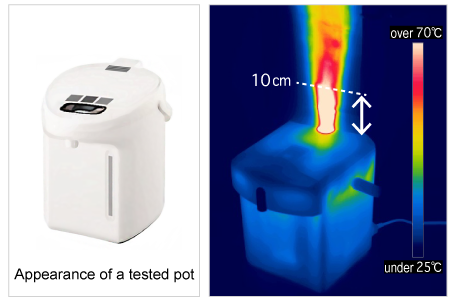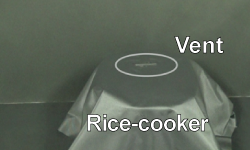Caution! Infants may be scalded by steam emitted from home appliances: rice-cookers, thermos pots, kettles and steam humidifiers
Some home electric appliances emit steam when operating. Among them, rice-cookers, thermos pots, kettles and steam humidifiers are often used on a daily basis. If skin touches hot steam from any of these appliances, it is highly likely that the skin is scalded. It is particularly dangerous for infants because infant skin is thinner than adult skin and is likely to be damaged deeper and more severely. Recently people stay home longer in the pandemic, so it appears that home appliances are used more often than used to be.
In about five years from FY2016, the Medical Facilities Network1 received 56 reports of infant scald burns2 caused by steam from an electric rice-cooker, electric thermos pot, electric kettle or steam humidifier. In February 2021, the Doctor Mailbox3 received a report that a patient got a scald burn of third degree4 caused by a steam humidifier and needed to go through skin graft surgery.
Then, NCAC has measured the temperature of steam emitted from the above-mentioned home appliances, including those claiming zero or less steam emission. In addition, NCAC has conducted a consumer questionnaire survey to find out how these home appliances are used and how scald injuries occur when using them. The following shows findings and preventive measures against steam scalds caused by home appliances.
- 1 The Medical Facilities Network is a joint project by the Consumer Affairs Agency and NCAC which started operating from December 2010. The network collects accident reports on people receiving treatment at medical facilities after suffering life-threatening or bodily injuries in their daily lives.
- 2 Data registered from April 2016 through the end of June 2021. The accident reports were sorted out and counted for this article.
- 3 In August 2014, NCAC set up a web page called "Doctor Mailbox" to catch information directly from doctors about accidental injuries caused by products or services in order to help prevent similar incidents.
- 4 Burn injuries are divided into three degrees based on the depth of burns. First degree burns damage only the epidermis. Second degree burns damage the epidermis and the dermis. Third degree burns go through the epidermis and dermis and affects deeper tissues.
Findings
Consumer questionnaire survey
- About 10% of the respondents encountered incidents where their infants were scalded or nearly scalded by steam emitted from home electric appliances.
- About 40% of the respondents did not expect infants would be scalded by steam emitted from home electric appliances.
- Those who did not encounter the above incidents were more likely to place home electric appliances at higher surfaces compared to those who encountered the incidents.
- Around 70% of the respondents didn't know that some types of individual home electric appliances had features to control steam emitted from them.
- Of the respondents who encountered the above incidents, more than 70% answered that home electric appliances should have been placed out of reach of infants to avoid the risk of steam scalds.
- Of the respondents who encountered the above incidents, more than 60% wanted a wider availability of home electric appliances operating without steam emission.
Steam temperature survey
- There was more than a 60 degrees Celsius difference between the temperature near the vent of electric rice-cookers representing a steam control feature and that of those not representing a steam control feature.
- There was more than a 60 degrees Celsius difference between the temperature near the vent of electric thermos pots representing a steam control feature and that of those not representing a steam control feature.
- There was more than a 60 degrees Celsius difference between the temperature near the spout of electric kettles representing a steam control feature and that of those not representing a steam control feature.
- There was nearly a 30 degrees Celsius difference between the temperature near the vent of steam humidifiers representing a steam control feature and that of those not representing a steam control feature.
Photo: Temperature distribution of steam emitted from an electric thermos pot not representing the steam control feature

Safety precautions
- Safety precautions against steam scalds are included in instruction manuals of all the tested products.
Advice for consumers
- There is a risk of scald from steam emitted by electric rice-cookers, electric thermos pots, electric kettles and steam humidifiers, even if the contact time is only a few seconds. Such an appliance should be placed on a high surface so that infants cannot touch steam emitted from it.
- When buying an electric rice-cooker, electric thermos pot, electric kettle or steam humidifier, think of choosing one with a steam control feature in order to prevent steam scalds.
Request to businesses
- Be specific and user-friendly in describing the risk of steam emitted from electric rice-cookers, electric thermos pots, electric kettles and steam humidifiers and how to prevent infants from steam scalds (e.g. where to place the appliances).
- Fully inform consumers and sellers of steam control features.
- More widely market the products with steam control features.
Request to the government
- Keep consumers (esp. parents and carers of infants) informed about the risk of steam from home electric appliances and preventive measures against injuries.
- Encourage manufacturers to improve product labels and instruction manuals so that consumers can more easily notice and understand the risk of steam.
Video

Video: Beware of infant scalds caused by steam emitted from home appliances!(Japanese version)
